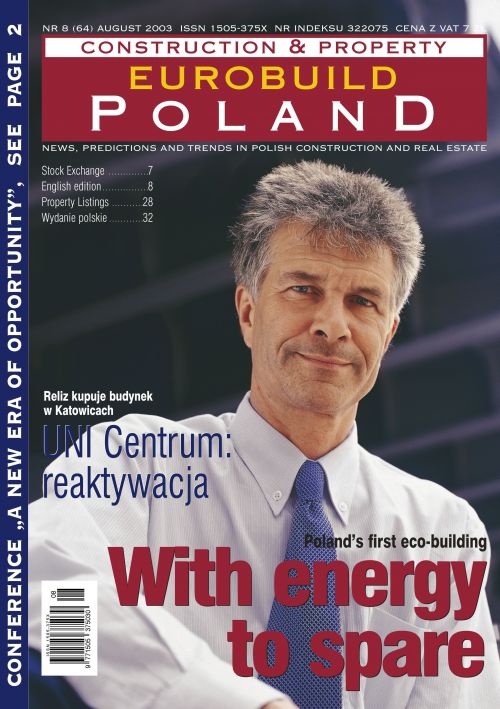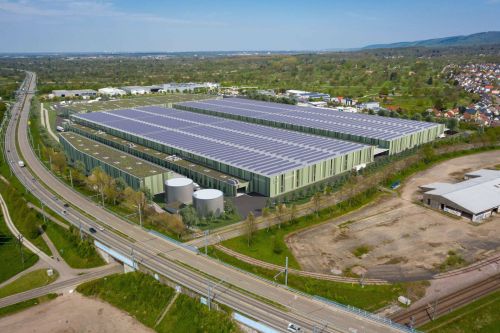With energy to spare
The 'eco-building' concept would seem to be as alien to Polish soil as Islamic Fundamentalism, if some reactions to the idea on the Warsaw market are anything to go by. But it could well enter the city's vocabulary along with Grontmij Real Estate Polska's Tulipan House
"If you go to Amsterdam," says Hans van de Sanden, Managing Director of the Dutch developer, "you will see that all the buildings of the last three years, to my big surprise, are being constructed with underground cold water storage, in order to cool the building. I worked in Amsterdam for five years and then that was unimaginable: today it is common practice." This method of regulating a building's temperature is characteristic of 'eco-buildings'.
Tulipan House, a 15,000 sqm building, construction on which is due to begin next year, is part of a European Union-inspired initiative, the SARA (Sustainable Architecture Applied to Replicable Public-Access Buildings) project, whose aim is "to construct sustainable, cost effective high-energy performance eco-buildings that are immediately replicable at large scale in many locations," according to the Project Summary. Eight public-access buildings in five EU member states, (Austria, Spain, France, Italy and the UK) two EU candidate countries, (Poland and Slovakia) and Uzbekistan are involved in the project. Of these, only Tulipan House and the Austrian project entail commercial office development.
Lower energy costs
Grontmij's brief under the auspices of the project, is to produce energy savings, which are 30 per cent more than other class A buildings in Warsaw. This they will strive to do by employing a "compilation of technologies", in van de Sanden's words. One of the innovations that will be implemented to save energy, includes a large atrium in front of the building, which will allow for both passive and active solar energy. Building materials will be chosen to optimize the saving of energy costs, as van der Sanden explains: "How much energy are you going to lose with the window frames: would it be better to use timber or aluminum? These discussions are ongoing."
But higher rents?
Though the eco-building concept does seem to have some time to go before it captures the imagination of real estate professionals in Poland, one plausible objection to the idea is that the capital outlay involved in this "compilation of technologies", is such that though energy costs might well be reduced, rents, arguably more important to the average tenant, may have to be hiked to recoup the initial investment.
Paul Lucas of Real Architecture, designers of an eco-building, the 1,347 sqm EcoTech Centre in Norfolk in the UK, which is currently seventy five per cent leased, explains that although in that country, "there's a movement afoot to incorporate this type of design", there is still a general "reluctance among clients to pay the extra life-cycle costs". Developers in the UK are hesitant to engage in such projects, "because they can't see the benefits" and tenants to move to them because "market value is their main concern". He also accepts that rents could well be higher, precisely because developers do need to recover the expense of the investment.
Though for many potential clients, the corporate kudos to be earned from working from an eco-building, might well swing the issue in the latter's favour, this doesn't mean landlords and agents of these will be aggressively foregrounding the 'green' status of their buildings.
"The ecology-side is a kind of selling point," says Hadley Dean of Colliers International, who are the exclusive leasing agents for Tulipan House, "but people may be a bit skeptical to start with. I'm however very confident we can show them that not only is it going to work, it's also going to save them money." He qualifies this point a little by remarking "we won't be fronting it as a wonderful ecological building but as modern architecture." Part of this marketing strategy will be to emphasize the atrium.
Helping out
Grontmij's involvement in the SARA Project would seem to have been a shrewd move however, because it comes with a subsidy of EUR 300,000 from the EC, to cover some of the extra expense of implementing that "compilation of technologies".
"We know some of the costs are additional, which is why we went to the EU and said "can you solve the problem for us?" We can say to our clients, to our bank and to our equity providers in the Netherlands, don't worry too much about the extra costs, because they will be subsidized. They will have value for money," says Hans van de Sanden. He also insists that rents will be no higher than comparable buildings arriving on-line in Warsaw at around the same time.
Of course one of the conditions of receiving the subsidy is that the aim of achieving that thirty per cent in energy savings, will very much have to be accomplished. Claiming that as the technologies to attain their goals already exist, Grontmij "won't have to invent anything, so we can do some shopping around and work things out with our own consultants," van de Sanden adds that "today we have a general layout of how we want to achieve the 30 per cent savings."
With service charges, which cover energy usage among other things, very much a bone of contention in Warsaw ("Landlords are ripping tenants off left, right and centre," says Hadley Dean), perhaps Warsaw's first eco-building won't be deemed such an oddity in the city after all.





















































